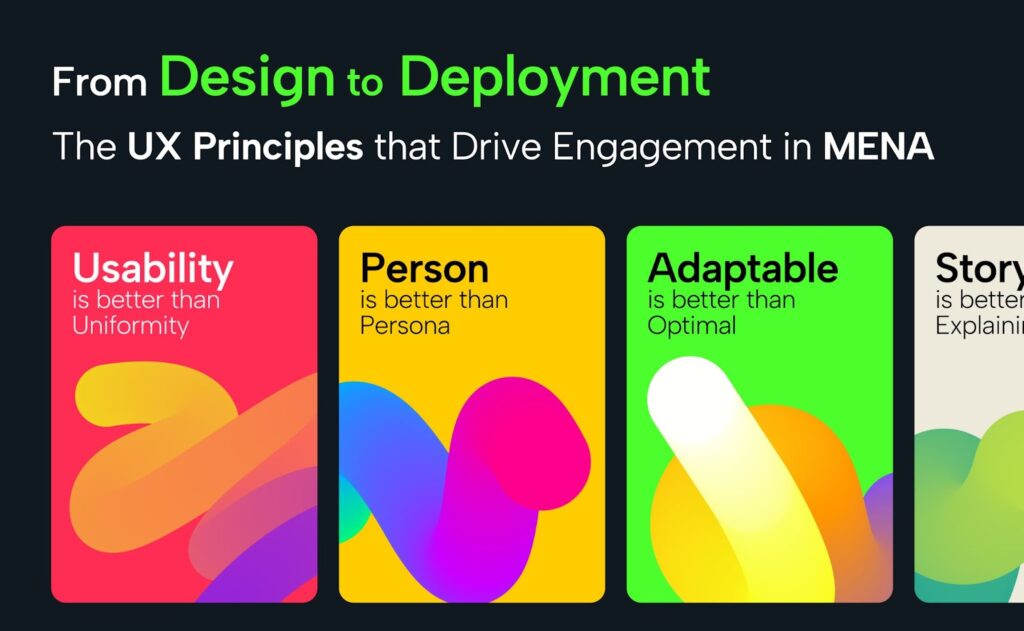From Design to Deployment: The UX Principles that Drive Engagement in MENA
Web design and development services that are very effective are not just concerned with writing code; rather, they are concerned with the creation of experiences. In the Middle East and North Africa (MENA) area, where the adoption of digital technology is accelerating and cultural context is of utmost importance, successful online initiatives strongly depend on user experience (UX).

From the first concept to the final launch, marketers that comprehend and incorporate MENA-specific user experience principles realise increased levels of engagement, conversions, and loyalty from their customers.
Importance of Culturally-Sensitive Design in the MENA Region
A hybrid of Arabic, Persian, Turkish, and even Western cultures, the Middle East and North Africa (MENA) region offers a digital environment that is one of a kind. Considering the linguistic, theological, and visual expectations that are associated with this variety, awareness is required. A 360 impact marketing agency emphasises that in order to have a great user experience in the Middle East, it is necessary to take into consideration the local culture, communication nuances, and unique digital behaviours shaping consumer expectations..
Features of the platform such as navigation from right to left for Arabic, colour symbolism that is culturally appropriate, and iconography that is in line with regional conventions are only the beginning. According to academic study on Arabic interface design, the use of appropriate fonts (for example, Arabic Droid Kufi for headers as opposed to Tahoma for body text) and visual aspects are essential, although they are often overlooked,has a direct impact on the readability and trustworthiness of the interface.
Start with Research: Understand Real Users
A non-negotiable need for efficient website design and development services is comprehensive user research that is conducted locally. Success or failure of your project in the MENA region can hinge on differences in digital literacy, payment preferences, and regional language diversity.
In order to get insights, platforms advocate in doing remote testing with actual users. This is particularly helpful in addressing difficulties with form fields, navigation, and compatibility with AI chat.
From young people who were born and raised in the digital age in the United Arab Emirates to senior Arabic speakers who are navigating mobile banking in Kuwait, user personas need to represent the complete range.
The inability to do so might cause even more complex functionality, such as chatbots, payment gateways, or content that is available in many languages, to fail.
UX in Telecom and Super Apps: Seamless, End-to-End Journeys
With regard to incorporating user experience (UX) innovation into their offerings, MENA telecom operators have been pioneers. Apps such as Virgin Mobile UAE and e&’s “Ease” kiosks, Etisalat and du are examples of the smooth and service-oriented experience that customers of today anticipate while using their mobile devices.
Mobile-First Strategy: A Necessity, Not an Option
The Middle East and North Africa (MENA) are dominated by smartphones. The demand for responsive and mobile-first design is a fundamental prerequisite, given that smartphone views have surpassed desktop views. In a recent analysis, Blue ME highlights the need of customising for mobile in order to guarantee usability and search engine optimisation success in the area.
Hyper-Personalization & Data-Driven UX
MENA consumers anticipate having encounters that provide a sense of being individualised. Everything from e-commerce ads with a Ramadan theme to loyalty benefits created by artificial intelligence has to be hyper-personalized.
Brands are investing in data-driven models that dynamically alter content, push real-time offers, and adjust pricing according to area, according to research on user experience trends in the Middle East.
In addition, businesses use Arabic and natural language processing chatbots that are able to identify colloquialisms, which increases both usability and brand attachment.
Accessibility & Inclusivity Across Abilities and Languages
Designing for everyone is the essence of true inclusion. A number of users in the Middle East and North Africa region have poor literacy rates, variable levels of digital abilities, and visual or movement impairments. Voice interfaces that are adapted to Arabic dialects, such as Yasmina, are becoming more important as crucial inclusion elements.
Security and Privacy: Building Trust from the Ground Up
When it comes to marketplaces that are heavily driven by privacy, digital trust is vital. MENA consumers anticipate a high level of security and transparency, particularly in regards to their personal data and financial transactions.
Clear permission, quick access to privacy settings, and frictionless access to assistance are all necessary components of a secure user experience design. Compliance with GDPR-style frameworks that are developing locally is something that design agencies need to guarantee.
Rigorous Testing: Analytics, Heatmaps, A/B
It is possible for even the most reputable website design and development company to overlook important adjustments. Small cultural variations in the positioning of buttons or the layout of forms may have a significant influence on performance in the Middle East and North Africa region. Apply stringent testing by means of heatmaps and session recordings in order to conduct an analysis of drop-offs.
Deployment and Ongoing Optimization
It is essential to do post-launch monitoring. Monitoring interaction patterns, content performance, bounce rates, and conversion flows may be accomplished via the use of analytics.
After Eid, do banners celebrating Ramadan lose their popularity? Are there any differences in navigation while switching languages? Are chatbots unable to respond to colloquial questions?
It is essential for website design and development services to include iterative monitoring, which provides insights that can be put into action and agile modifications in reaction to trends.
Final Thoughts
Companies who provide website design and development services in Gulf cities are required to adopt these concepts in order to increase customer engagement and the influence they have on their businesses.
Providing highly resonant digital experiences is something that companies are able to do by comprehending and incorporating five foundations of user experience (UX), which include inclusive design, Arabic-first interfaces, testing, and analytics. Your user experience (UX) is your competitive edge in a location where cultural subtlety and digital ambition coincide.
Let’s create digital experiences together. Not only do audiences in MENA utilise, but they also remember.





